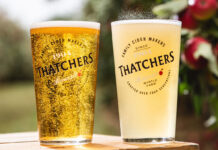Producers say low ABV is more popular than ever in on-trade
LOW ABV beers and ciders are proving increasingly popular in Scotland’s pubs and bars, say drinks firms.
And they insist ‘no-alcohol’ doesn’t have to mean ‘no flavour’.
Jodie Alliss, brand manager at Kopparberg, said the cider firm has had an “extremely positive” response to its own low ABV selection.
“Alcohol-free products have always been an important part of the on-trade, whether for designated drivers or those looking to moderate their alcohol intake,” she said.

In November the Swedish cider brand added Kopparberg Alcohol Free Strawberry & Lime flavour to its low ABV range, which already included Pear and Mixed Fruit variants.
Alliss added: “Our alcohol-free ciders don’t compromise on taste and offer a way for retailers to capitalise on the increasing demand for alcohol-free products and occasions.”
Presentation is key to making customers aware of a low ABV range, according to Graham Archibald, sales director at Morgenrot, whose portfolio includes Alhambra Sin and Krombacher Low Alcohol Pils.
He said: “My advice for the Scottish on-trade selling and merchandising low alcohol and no-alcohol lines is to stock good-tasting brands and promote them the way they deserve.”
Low and no-alcohol products may have been available to the trade for years, but Danny Wan, of Dutch brewer Bavaria, said there has “undoubtedly been an increased demand” for them this year.
And he advised that these products can have a significant impact on operators’ profit margins.
He said: “As alcohol-free beer has no duty then margin opportunities for alcohol-free drinks can be substantially higher than alcoholic drinks. Depending on the RSP, licensees can make over 70% margin on alcohol-free beers.”
Tennent Caledonian now offers the 2.8% ABV Lemon T and 0.05% ABV Hee-Haw in its bottled beer range.
Chief executive Brian Calder said: “It’s important for operators to look at what categories are working for them and invest in both low and no ABV options within these.”
He said it “makes perfect sense” to offer low and no ABV options in the fridge or on tap. Calder also highlighted the importance of ensuring staff are knowledgeable about low ABV categories.
He added: “Staff are there to respond to consumer needs and should be able to advise customers who are looking to enjoy a lower or no-alcohol drink.”
























